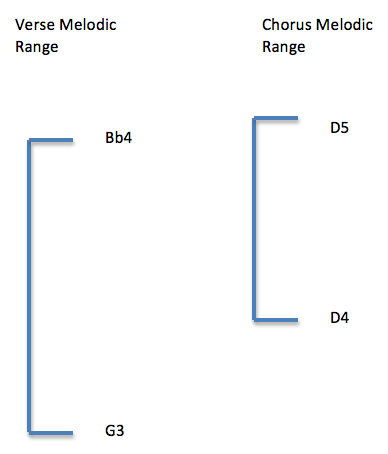In most songs, the chorus is considered to be, musically speaking, more energetic than the verse. There are lots of ways that the higher energy is attained, some of which are the producer’s responsibility: instrumentation, playing style, volume, etc.
And some of ways to achieve higher energy are the songwriter’s responsibility: higher emotions in the lyric, simpler and stronger chord progressions, and busier rhythms in the backing instruments. And probably the most important one: a higher chorus melody.
The human voice sounds more strained and intense when it moves higher, and we interpret that strain as an increase in musical energy. But if you look at most pop songs, the chorus isn’t usually a lot higher. Most of the time, it only needs to be a bit higher, maybe a note or two. This means that the verse and chorus ranges will overlap considerably.
Michael Jackson’s “Billie Jean” is a good example of this kind of overlapping range when comparing verse (including pre-chorus) to chorus (notes from the key of G minor):

As you can see, the melodic range of the chorus isn’t a lot different from the verse range. But it’s noteworthy that it’s not just that the chorus explores a higher range, hitting D5 near the end of the chorus: the verse explores a lower range.
Every song will be different, of course, and as I’ve pointed out on this blog before, there are songs where the chorus is actually a bit lower than the verse. That’s because the actual principle involved is that there needs to be higher musical energy in the chorus, and moving the melody higher is only one way to do that.
If you find in your own songs that things sound a bit boring, one of the first places to look is to compare the verse and chorus ranges. If you find that both sections sit in the same basic range, you’ve probably identified the cause of the problem.
The solution will either be to find ways to allow the verse to move lower, or to find ways to move the chorus melody higher. Either way, the difference between the verse and chorus doesn’t need to be a lot. Hitting one higher note (like the high D at the end of the “Billie Jean” chorus) may be all that’s needed to boost musical energy.
 Written by Gary Ewer. Follow Gary on Twitter.
Written by Gary Ewer. Follow Gary on Twitter.
 Get “The Essential Secrets of Songwriting” eBooks. They’ll help you polish your technique, and make you the best songwriter you can be. Comes with a Study Guide, tons of chord progressions, and information covering every aspect of how to write good music.
Get “The Essential Secrets of Songwriting” eBooks. They’ll help you polish your technique, and make you the best songwriter you can be. Comes with a Study Guide, tons of chord progressions, and information covering every aspect of how to write good music.










